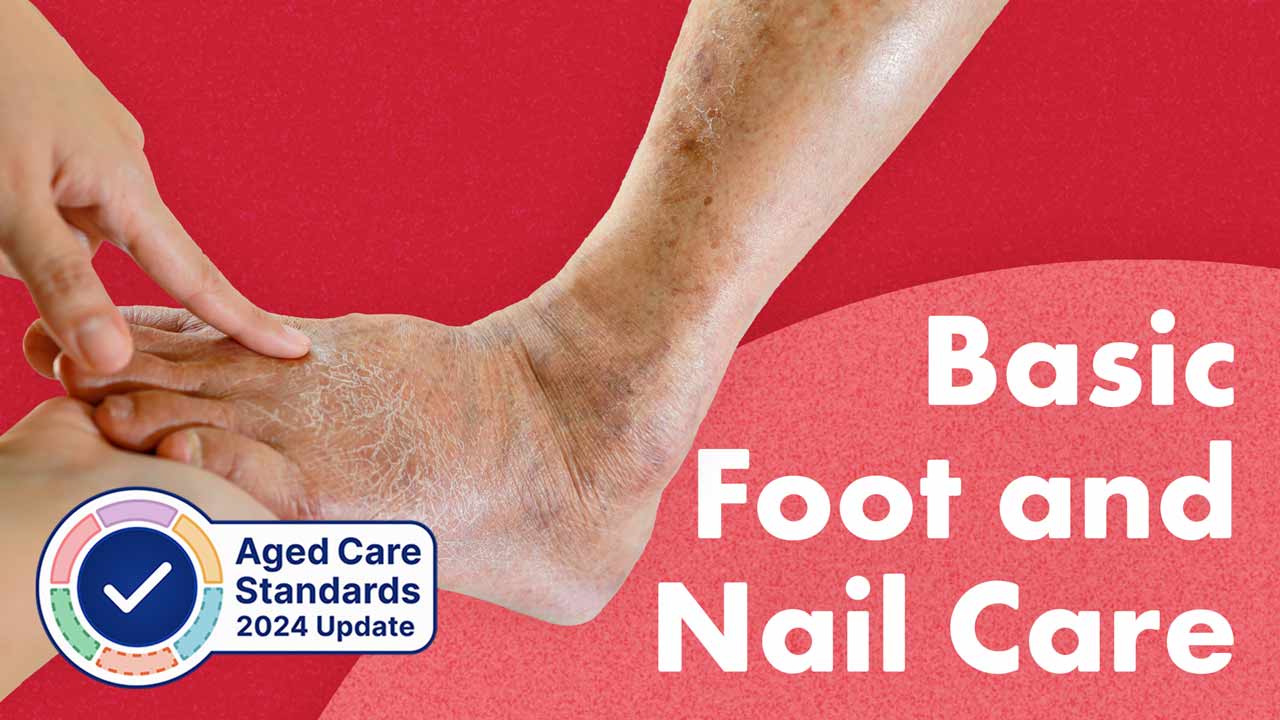Foot issues are common in aged care - in fact, foot pain affects approximately one in four older people (Menz 2016).
Feet should not be overlooked. Foot health conditions can have severe implications, including:
- Impaired mobility and balance
- Reduced independence
- Increased risk of falls
- Diminished quality of life.
(Menz 2016)
Foot and Nail Care Under the Strengthened Aged Care Quality Standards
Standard 3: Care and Services - Outcome 3.2: Delivery of care and services under the strengthened Aged Care Quality Standards (Action 3.2.2) requires care and services to be delivered in a way that promotes quality of life, reablement, and maintenance of function. This includes the provision of personal care (ACQSC 2024).
How Do Feet Change With Age?
There are several age-related factors that make older adults more susceptible to foot damage.
The fatty cushioning under the heels and balls of the feet thins, and the skin on the feet loses its elasticity and strength. Furthermore, toenails become more brittle, thick, and hard. This makes them more difficult to trim, and therefore, increases the risk of ingrown toenails, fungal breakouts, and infection (APodA 2018a).
Additionally, many older people may struggle with foot care as they grapple with other impairments such as poor vision and restricted mobility (APodA 2018b).
On the more extreme end of foot complications are bone deformities, such as bunions and arthritis. These deformities can implicate foot care and lead to an increase in falls (APodA 2018a).

Common Foot Conditions
- Arch pain (plantar fasciitis): Causes include incorrect footwear, flat feet, and walking on hard surfaces
- Tinea: Also called ‘athlete’s foot’, tinea is an infection characterised by a red, itchy rash
- Bunions: Bunions can push the toes and feet out of shape
- Warts: Can appear on the sole, heel, or toes
- Corns and calluses: A result of pressure from footwear or walking
- Ingrown toenail: A toenail curls down and grows into the skin
- Diabetes-related foot disease (DFD): DFD most commonly occurs in people with diabetic peripheral neuropathy. It results in an insensitive and often deformed foot.
(Healthdirect 2021, 2023; Better Health Channel 2023)

Foot Care for Older Adults
- Wash and dry feet every day with warm water and mild soap (including between the toes)
- Check for problems such as cuts, bruises, blisters, swelling, and pus
- Moisturise the skin
- Avoid over-the-counter corn cures.
- Ensure that shoes fit correctly
- Encourage sensible, supportive footwear
- Change socks daily
- Recommend older people use a hand mirror to check underneath their feet
- Recommend an annual foot check by a podiatrist.
(APodA 2018b; Healthdirect 2021; Limbs 4 Life 2018a; Diabetes Australia 2023; Eureka Medical & Dental Centre 2020)

Foot Injuries
Injuries such as cuts, blisters, sores, red areas, or cracks should be tended to immediately.
If caring for an older person with a foot injury:
- Wash and dry the area with care
- Apply antiseptic
- Dress with a sterile dressing
- Monitor the healing of the wound over a 24-hour period and seek timely medical attention if it does not improve.
(Diabetes Australia 2023)
Nail Care for Older People
- Nails should be cut straight across and filed smooth by a podiatrist
- Thick and ingrown nails should be attended to by a podiatrist
- Rub moisturiser into the skin around the nails
- Changes in nails, such as in colour, swelling, texture, or signs of bleeding should be monitored.
(Mayo Clinic 2022)
Preventing Nail Problems
- Ensure the person is wearing shoes that fit them
- Nails should be trimmed properly by a podiatrist. This involves soaking the feet beforehand, cutting straight across the nail and not tapering corners or trimming too short
- Keep the feet clean and dry.
(Healthdirect 2023)
Illnesses That May Affect Foot Health
- Arthritis can manifest in many forms and has the potential to damage the joints of the feet
- Diabetes can damage the nerves in the feet, reducing blood flow and increasing the risk of infection
- Poor blood flow can lead to skin changes, pain, coldness, and splintered toenails.
(Healthdirect 2021
Test Your Knowledge
Question 1 of 3
Which one of the following is NOT a step in nail care?
Topics
References
- Aged Care Quality and Safety Commission 2024, Standard 3: Care and Services, Australian Government, viewed 3 May 2024, https://www.health.gov.au/resources/publications/strengthened-aged-care-quality-standards-august-2025?language=en
- Australian Podiatry Association 2018a, Ageing Feet, APodA, viewed 1 May 2024, https://www.podiatry.org.au/foot-health-resources/ageing-feet
- Australian Podiatry Association 2018b, Ageing Feet: Foot Health and Ageing, APodA, viewed 3 May 2024, https://www.podiatry.org.au/foot-health-resources/ageing-feet-2
- Better Health Channel 2023, Diabetes - Foot Care, Victoria State Government, viewed 1 May 2024, https://www.betterhealth.vic.gov.au/health/conditionsandtreatments/diabetes-foot-care
- Diabetes Australia 2023, Diabetes and Your Feet, Diabetes Australia, viewed 3 May 2024, https://www.diabetesaustralia.com.au/living-with-diabetes/preventing-complications/foot-care/
- Eureka Medical & Dental Centre 2020, Easy Foot-Care Guide for a General Health Boost, ForHealth Group, viewed 3 May 2024, https://www.eurekamedical.com.au/articles/physio/easy-foot-care-guide-for-a-general-health-boost/
- Healthdirect 2021, Foot Care, Australian Government, viewed 1 May 2024, https://www.healthdirect.gov.au/foot-care
- Healthdirect 2023, Ingrown Toenails, Australian Government, viewed 1 May 2024, https://www.healthdirect.gov.au/ingrown-toenails
- Limbs 4 Life 2018, Foot Care, Limbs 4 Life, viewed 3 May 2024, https://www.limbs4life.org.au/health-matters/foot-care
- Mayo Clinic 2022, Fingernails: Do's and Don'ts for Healthy Nails, Mayo Clinic, viewed 3 May 2024, https://www.mayoclinic.org/healthy-lifestyle/adult-health/in-depth/nails/art-20044954
- Menz, H B 2016, ‘Chronic Foot Pain in Older People’, Maturitas, vol. 91, viewed 1 May 2024, https://www.sciencedirect.com/science/article/pii/S0378512216301438
 New
New 
